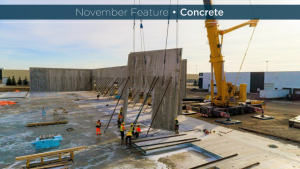Owners, contractors and subs are eager to take meaningful steps to decarbonize the construction industry and supply chain.
However, many still lack knowledge about the issue and how to move the needle.
That was one of the findings that came to light during a recent roundtable of panellists and leaders from various sectors of the industry who gathered to focus on tactical ways to eliminate carbon emissions.
“If you’re a general contractor – or if you’re a subcontractor in Canada – 90 per cent of your footprint is the embodied carbon of the materials that you put in place on jobsites,” explained Tim Coldwell, president of Chandos Construction, who moderated the discussion. “Most subcontractors, and frankly most general contractors, don’t even understand the concept of embodied carbon.
“I rub shoulders with the CEOs of the largest construction companies in Canada. These are really smart guys and gals, and I would bet that only half of them would be able to explain the difference between embodied carbon and operational carbon. So, underneath all of it, there is a complete void of basic knowledge in terms of like what your footprint might actually be as an organization.”
Coldwell noted understanding embodied carbon, which is all the carbon emitted to produce and put-in-place materials and processes required to build a building, is critical if the industry is to tackle the problem.
During the roundtable, aptly called Decarbonizing the Construction Industry Supply Chain, panellists and industry leaders discussed how to eliminate carbon emissions related to the selection of building materials, the supply of the construction elements, the movement of personnel and management of waste from an energy and carbon use perspective.
As raw materials are extracted, cooked, carved up, altered, turned into building products, transported to and constructed onsite, carbon is produced and emitted.
While there’s a feeling that strides are being made, Coldwell believes there’s a need for more action by the industry.
Coldwell said there is a need for many owners, generals and subcontractors to do a deeper dive and track the components of carbon emissions embedded in every building decision.
“Details really matter. You can’t just skip across the surface. Once you kind of brush up on that, people in construction are thinking, ‘Well, it’s going to be the carbon I burn on utilities,’ and ‘I’ve got diesel equipment, I’ve got transportation, I’ve got this, that and the other thing.’ Those are scope one and two. But 90 per cent of our industry is rolled up in scope three, so down the supply chain.”
To reduce the embodied carbon on a project, industry personnel must acquire more knowledge about the supply chain.
“So, we need to know where to buy low-carbon engineered floor for the same price as the other engineered floor,” said Coldwell.
Owners, generals and subs have an opportunity to lead on reducing the carbon footprint of a project. For example, Coldwell noted if owners set a goal to reduce the embodied carbon on a project by 30 per cent, generals will take notice and, when selecting subs, will expect them to follow suit. He figures generals can influence carbon reduction because they’re in a unique position.
“Generals should turn around, because we’re in the middle of the supply chain, and do the same with our subcontractors. We should say, ‘When we’re picking the electrical guy, what are we doing about embodied carbon?’ You just push it all the way down the supply chain and make it part of selection criteria.”
The design community also has a big part to play because architects can inform contractors about lower carbon materials that could be used, said Coldwell.
To fairly assess products and processes from a carbon perspective, identifiers like an Environmental Product Declaration attempt to introduce transparency to the construction supply chain by using a standardized approach to calculating embodied carbon.
However, Coldwell raises the spectre that there is inconsistency in methodologies used by the various industries.
“There is a lot of nonsense that goes on in quantifying embodied carbon and materials right now. It’s a little bit like the Wild West.”
For example, the wood industry often claims negative embodied carbon because it is stored in the timber. However, Coldwell maintains that’s nonsense because eventually when a structure is demolished and the wood is sent to landfills or is burned, the carbon that was stored gets released.
“There’s like a friendly arms race around decarbonization that’s happening among the three big material guys,” he said. “Right now, mass timber wins the day just by a nose on a mid-rise office building.”











Recent Comments
comments for this post are closed